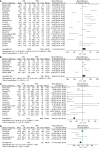Laparoscopic Versus Open Partial Nephrectomy: A Systemic Review and Meta-Analysis of Surgical, Oncological, and Functional Outcomes
- PMID: 33194725
- PMCID: PMC7658533
- DOI: 10.3389/fonc.2020.583979
Laparoscopic Versus Open Partial Nephrectomy: A Systemic Review and Meta-Analysis of Surgical, Oncological, and Functional Outcomes
Abstract
Purpose: To summarize and analyze the current evidence about surgical, oncological, and functional outcomes between laparoscopic partial nephrectomy (LPN) and open partial nephrectomy (OPN).
Materials and methods: Through a systematical search of multiple scientific databases in March 2020, we performed a systematic review and cumulative meta-analysis. Meanwhile, we assessed the quality of the relevant evidence according to the framework in the Cochrane Handbook for Systematic Reviews of Interventions.
Results: A total of 26 studies with 8095 patients were included. There was no statistical difference between the LPN and OPN in the terms of operation time (p=0.13), intraoperative complications (p=0.94), recurrence (p=0.56), cancer-specific survival (p=0.72), disease-free survival (p=0.72), and variations of estimated glomerular filtration rate (p=0.31). The LPN group had significantly less estimated blood loss (P<0.00001), lower blood transfusion (p=0.04), shorter length of hospital stay (p<0.00001), lower total (p=0.03) and postoperative complications (p=0.02), higher positive surgical margin (p=0.005), higher overall survival (p<0.00001), and less increased serum creatinine (p=0.002). The subgroup analysis showed that no clinically meaningful differences were found for T1a tumors in terms of operation time (p=0.11) and positive surgical margin (p=0.23). In addition, the subgroup analysis also suggested that less estimated blood loss (p<0.0001) and shorter length of hospital stay (p<0.00001) were associated with the LPN group for T1a tumors.
Conclusions: This meta-analysis revealed that the LPN is a feasible and safe alternative to the OPN with comparable surgical, oncologic, and functional outcomes. However, the results should be applied prudently in the clinic because of the low quality of evidence. Further quality studies are needed to evaluate the effectiveness LPN and its postoperative quality of life compared with OPN.
Keywords: kidney neoplasm; laparoscopy; nephrectomy; surgical procedures; treatment outcomes.
Copyright © 2020 You, Du, Wang, Peng, Wei, Zhang, Li and Wang.
Figures







References
-
- Ljungberg B, Albiges L, Bensalah K, Bex A, Giles RH, Hora M, et al. EAU Guidelines on Renal Cell Carcinoma 2020. In: European Association of Urology Guidelines 2020 Edition. presented at the EAU Annual Congress Amsterdam 2020. Arnhem, The Netherlands: European Association of Urology Guidelines Office; (2020).
-
- Tae JH, Pyun JH, Shim JS, Cho S, Kang SG, Ko YH, et al. Oncological and functional outcomes of robot-assisted radical cystectomy in bladder cancer patients in a single tertiary center: Can these be preserved throughout the learning curve? Invest Clin Urol (2019) 60(6):463–71. 10.4111/icu.2019.60.6.463 - DOI - PMC - PubMed
-
- Van Poppel H, Da Pozzo L, Albrecht W, Matveev V, Bono A, Borkowski A, et al. A prospective, randomised EORTC intergroup phase 3 study comparing the oncologic outcome of elective nephron-sparing surgery and radical nephrectomy for low-stage renal cell carcinoma. Eur Urol (2011) 59(4):543–52. 10.1016/j.eururo.2010.12.013 - DOI - PubMed
Publication types
LinkOut - more resources
Full Text Sources
Research Materials

